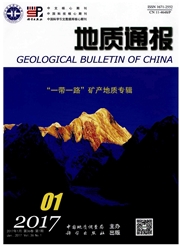

 中文摘要:
中文摘要:
以便更好理解 Qaidam 盆的构造进化。作者从 Hongsanhan 节在 7 个地点的 39 件样品上执行了 paleomagnetic 研究,西北 Qaidam 盆。逐步的 thermo 除去磁性孤立一个高温度的部件(HTC ) ,它在 95% 信心水平通过褶层和颠倒测试。它建议 HTC 应该是主要的。解块的温度(大约 685 ) 和等温的顽磁的实验显示赤铁矿是主要顽磁的搬运人。一个倾斜改正平均数方向是:Ds=7.1 ?? 代 ??? 欠??
 英文摘要:
英文摘要:
In order to better understand the tectonic evolution of the Qaidam Basin. The authors carried out a paleomagnetic study on 39 samples of 7 sites from Hongsanhan section, northwest Qaidam Basin. Stepwise thermo-demagnefizafion isolated a high-temperature component (HTC), which passes the fold and reversal tests at 95 % confidence level. It suggests that the HTC should be primary. Unblocking temperature (about 685℃ ) and the experiment of isothermal remanence indicate that hematite is the mainly carrier of the remanence. A tilt-corrected mean direction is: Ds= 7.1°, Is= 38.5°, α95 = 7.4°. Corresponding to a palaeopole at, φ= 250. 1°E, λ= 72.0°N, A95 = 6.8°, Compared with the reference APWP of Eurasia, the sampling area occurred a non-significant rotation (3.4° ± 5.5°) relative to Eurasia since Eocene due to the affect of left-lateral Altyn fault, Based on the paleomagnetic results of early Cretaceous and Teritary within the Qaidam block, we can obtained the mean clockwise rotations from the samples deposited from 160 Ma to 45 Ma is 24.5° ± 9.0°, and from 38 Ma to present is - 0.5° ± 7.5° relative to present geomagnetism respectively. During the Mid Eocene (45 -38 Ma) rotation phase, there should existing an important early tectonic event in northern part of the present-day Tibetan Plateau, which probably represents one of large-scale strike-slip events of the Altyn strike-slip fault.
 同期刊论文项目
同期刊论文项目
 同项目期刊论文
同项目期刊论文
 40Ar/39Ar ages of the blueschist facies pelitic schists from Qingshuigou in the Northern Qilian Moun
40Ar/39Ar ages of the blueschist facies pelitic schists from Qingshuigou in the Northern Qilian Moun Monitoring Cenozoic climate evolution of northeastern Tibet: stable isotope constraints from the wes
Monitoring Cenozoic climate evolution of northeastern Tibet: stable isotope constraints from the wes 40Ar/39Ar ages of detrital white mica constrain the Cenozoic development of the intracontinental Qai
40Ar/39Ar ages of detrital white mica constrain the Cenozoic development of the intracontinental Qai 40Ar/39Ar dating of detrital white mica as a complementary tool for provenance analysis: a case stud
40Ar/39Ar dating of detrital white mica as a complementary tool for provenance analysis: a case stud 期刊信息
期刊信息
